This article is the second part of our series on how the COVID-19 pandemic and its associated lockdowns have impacted the livelihoods of three Indian transhumant pastoralist communities—the Van Gujjars, the Bakarwals, and the Raikas. To read part one, our primer on pastoralism during a pandemic, click here. Click here for part three on the Gujjar-Bakarwals.
Editor’s note: This story contains a photograph of a deceased buffalo. Reader’s discretion is advised.
In 2021, when the world is reeling under the COVID-19 pandemic and people are forced to stay put in their homes, it is hard to imagine that communities like the Van Gujjars still practise nomadism.
After all, as this series has already noted, there have been numerous endeavors taken by the Forest Department and district administrations to inhibit the practice of transhumance pastoralism amongst the Van Gujjars, either through wildlife and conservation policies, or through reduced access to markets. For the Department, the community’s historical grazing does not register as a right of theirs, deserving of legal protection. Rather, it is viewed as a special privilege: access to grazing lands is granted to herders at the discretion and benevolence of administrators under strict conditions. All of this is subtly done in the hope that they will be sedentarized and thus, “civilized”.
And so, the COVID-19 pandemic and the lockdowns that ensued too were an additional shock created for transhumant pastoral communities: whose seasonal migration amidst times of stillness has now come under State scrutiny.
The policy measures pursuant to the lockdown have generated skepticism within the Van Gujjars on their way of life. These pastoralists usually reside deep within forests to graze their cattle and do not have much interaction with other populations, except when passing through villages while migrating. The Van Gujjars believe that these restrictions on movement are another excuse for the Forest Department to assert its dominance over the forests and inhibit their traditional livelihoods, despite the community practising physical distancing during the lockdowns.
To understand the intricacies of migrating during a pandemic from the ground, Mohamad Meer Hamja, President of the Van Gujjar Tribal Yuva Sanghatan, and I decided to visit Van Gujjar families migrating to the bugyals—or high-altitude pastures—for the summer months in Uttarakhand’s Tehri Garhwal district. How were the community members coping with the transit to their summer homesteads after the pandemic-induced lockdowns last year? One year later, what are their experiences of transit like now?
What seems to be clear is that the year-long imposition of lockdowns and other COVID-19 policies within the Protected Areas that Van Gujjars regularly inhabit during the summer to graze their cattle have diminished their autonomy over their livelihood.
Documenting the Transhumance Process
The name Van Gujjar itself stems from their existence within the forest—or ‘van’. And so, their migratory movements must also be viewed in this light: these are transits from one forest to the other. The primary aim of these journeys is to feed their buffaloes, the community’s only source of livelihood. Their experiences within the forests are reflected in Van Gujjar folklore: where despite being beset with multiple problems of survival, the community expresses its love for Uttarakhand’s dense forests.
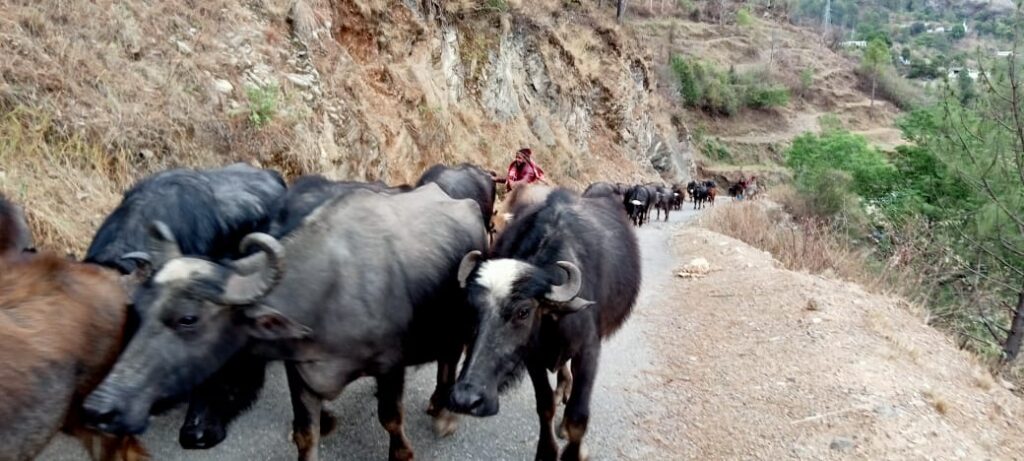
The entire phenomenon of migration requires adequate preparedness and resilience, especially when faced with the unexpected exigencies that arise in transit: the entire exercise of migration towards higher bugyals in the Himalayas, depending on the routes followed, takes approximately 25 to 30 days. The migrations proper, whether uphill or downhill, can last up to one month, as many travel a distance of some 250 to 300 kilometres each way.
It is pertinent to note that the Van Gujjar families that continue to pursue transhumance are those that possess a large number of buffaloes, making it expedient to find new grazing pastures for fodder and the exercise a sustainable one to pursue even today. Abdul Gani, a Van Gujjar from Kunao Chaud, migrates with 100 buffaloes for approximately 200 kilometers to the Kukodiya bugyals in Uttarkashi district every summer. “Unlike Kunao in the summers, it rains often in the bugyal. This ensures that the grass remains fresh and edible for the buffaloes to consume with ease,” says Gani. So, even though Gani spends between ₹30,000 to ₹35,000 in transit, the journey remains worthwhile for his livestock and family. Roshan Deen, a Van Gujjar from Kunao Chaud in Uttarakhand’s Gohri range, owns 60 buffaloes. Deen’s entire family commences their migration by mid-March annually, depending on the signs of restlessness shown by the buffaloes. “The buffalo is an integral part of our pastoral tradition, our entire family follows where the buffalo goes,” says Deen. “The buffaloes impose the rhythm of the walk, it follows its own pace.”
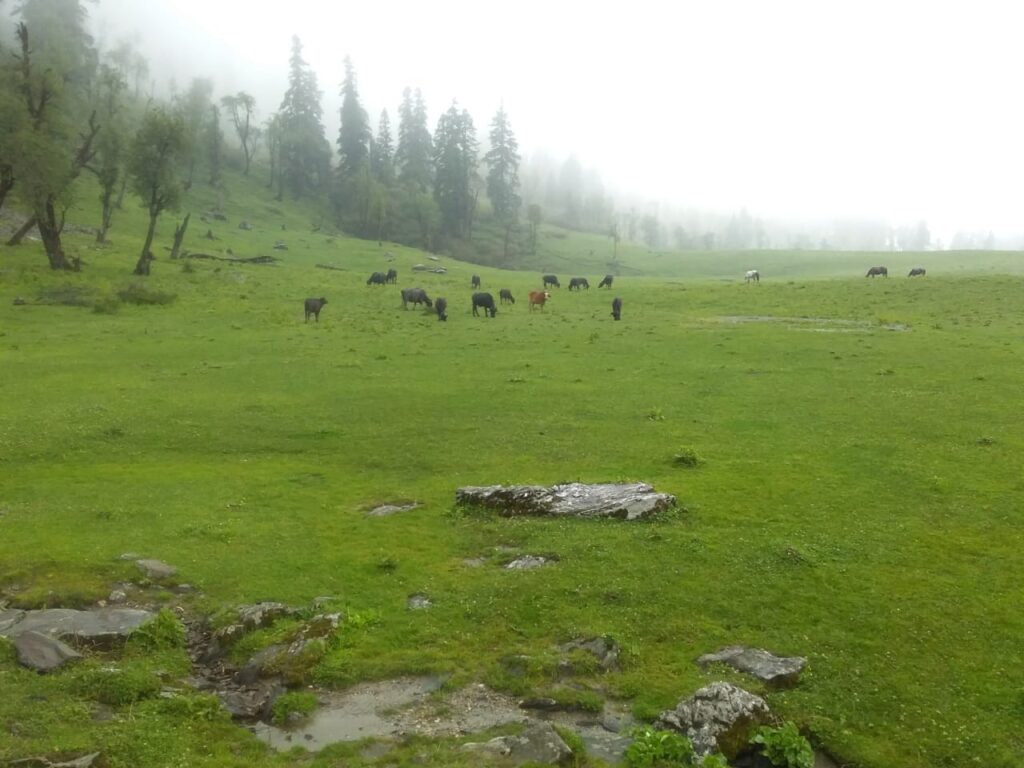
When it comes to how many Van Gujjars accompany these buffaloes, Amir Hasan writes that a number of families, approximately 8 to 10, join together to form a caravan, commonly referred to as a Qafila in Gojri, the language spoken by the pastoralists [1]. This Qafila includes Van Gujjars from neighbouring tappars—or patches of grasslands—and forest compartments, with certain Maais (Chief graziers) determining the transit route. The Qafila moves across both metalled roads, as well as forested valleys, and alongside roads based on a chartered path they follow year after year, with numerous halts in the journey. Paquet argues that women take the forefront in the migration by making first contact with any outsiders on the way, leading the initial negotiations with villagers or the Forest Department [2].
The exercise of migration also involves significant coordination between these families in order to smoothly transit without overcrowding the route. Van Gujjars have dedicated margs—or routes—that they follow when traveling from their winter homesteads in Saharanpur, Dehradun, and Haridwar districts, to the higher reaches of the Chakrata, Pauri Garhwal, Tehri Garhwal, and Uttarkashi districts. Some also migrate to Chaupal, Rohru, and Simla divisions in Himachal Pradesh, to the bugyals where they possess access permits to the lands.
The Van Gujjar Qafilas take breaks while migrating—which last for a day or two while climbing upwards—and are called paraos. The parao is an interim space of rest and recuperation for both the Van Gujjars and their buffaloes to graze and quench their thirst. More importantly, it also acts like a pitstop for the Van Gujjars during their month-long transit cycle between their summer and winter homesteads and vice versa. Between the two homesteads, the average number of paraos the Van Gujjars usually halt at are in approximately 10 to 12 different regions.
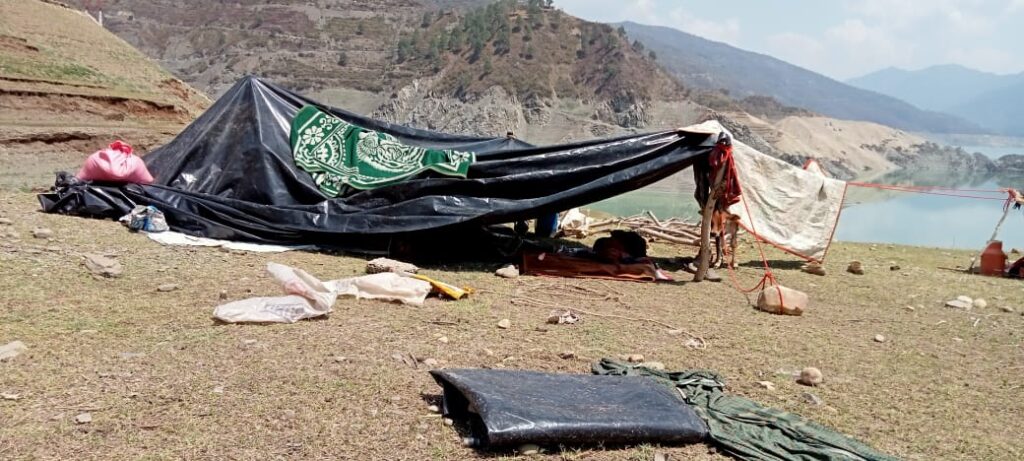
Ghulam Rasool is a resident of Shyampur near Rishikesh during the winters, who we met at the Van Gujjar parao at Uttarakhand’s Dobra Chanti Pul, tells us why this migration upwards is important during hot weather. Every summer, his family prefers to migrate to Gidhara in Uttarkashi district as they possess valid permits to access the forests there. “Our buffaloes need adequate grazing lands and fodder during the summer, which are absent in the Terai plains,” says Rasool. “The lack of food security and unbearable heat makes the bugyals preferable for the nourishment of the livestock population. Compared to our own health, if our buffaloes are healthy, we will have greater income security and be healthy.”
In most of the paraos, the Van Gujjars have a close understanding with the nearby village folk on their temporary halt on the rural commons, and on the arrangement of fodder and feed. Although symbolised by rest, it is an impermanent space that is occupied, set up, and dismantled in no time. While the area of the pitstop is certain for the Maais even prior to commencing of the transit, the space they occupy is far from fixed. The padao symbolises a life in a flux where a shan—or roof—is as light as a sheet held up by sticks.
Another integral travel companion during migration is the horse. Playing the role of ‘beasts of burden’, these animals help the Van Gujjars transport their household supplies, utensils, clothing, and temporary huts used in the paraos. Once in the bugyals of Uttarkashi and Rudraprayag, these horses also help in transporting religious pilgrims travelling to Uttarakhand for the Char Dham yatra, as well as for other pilgrimages during the summer.
Once the Van Gujjars reach the final destination within the bugyals, horses and buffaloes in tow, they set up residences of wood and thatched grass deras, although these deras are not as elaborate as their winter dwellings in the Terai Bhabar region. That being said, the romanticism attached to the Van Gujjar summer homestead is much more, despite it being a shorter stay of four months. The deras are located near water sources to ensure there is adequate supply of fresh drinking water for the families and livestock. And as lopping is prohibited during the summer season, the Van Gujjars choose to set up their homesteads in bugyals that possess adequate scope for chugai—or grass grazing.
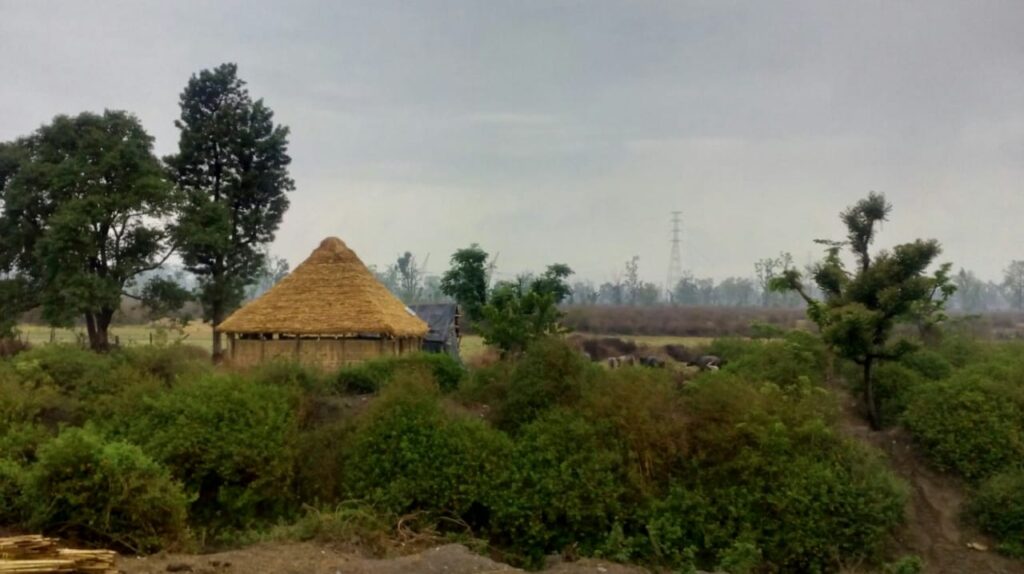
Previously, Van Gujjars like Deen would migrate along with their entire families and livestock. However, over the generations, there has been a shift in this practice, with fewer families and members within the family undertaking the journey. Recently, a change in marg has been noticed due to the lack of permits to access certain bugyals. This has led some families to pursue downward migration alongside the Ganga to pastures around Khadar, in Uttar Pradesh’s Bijnor district, Uttar Pradesh.
This has to do with the fact that the Van Gujjar’s customary and free access to the forests and mountains described here has been complicated by colonial forestry, which continues to shape much of independent India’s forest governance paradigms. As seen, Van Gujjars now require permissions and permits from local authorities—such as the Forest Department—to enter the forests, which shapes their patterns of movement, and the futures of their livelihood as well.
How Colonial Forest Governance Brings the Van Gujjars to a Halt
While the Van Gujjars possess legitimate permits to access their summer and winter homesteads, the Forest Department has made maintaining long-term access to bugyals cumbersome.
The colonial Forest Department initially set differential rates to access grazing lands. Local villages were allowed to graze on the basis of concessional rates in limited compartments. While the Van Gujjars had unlimited access rights to graze, they had to pay equivalent professional rates that were three to four times that of the concessional rates.
Yet, till date the Department has not sought to redistribute the additional fees charged on the nomads to assuage the resource conflict developing between the settled locals and the Van Gujjars. The logic of increased grazing fees for Van Gujjars—to discipline them into rearing a lesser number of buffaloes—did not hold. To ensure steady payment of these fees, the community simply started raising more cattle. Despite the Forest Rights Act, 2006 (FRA)—which empowers forest dwellers’ customary rights to access forest land—several Van Gujjars in Uttarakhand are illegally made to pay fees, penalties, or fines for violating these preconditions set forth by the Forest Department [3].
Importantly, these documents handed out by the State are viewed as a mere concession for the community to access the forest. Yet, for the Van Gujjars, these papers symbolize their relationship with jungles and forests which legitimately belong to them, their ancestors, or their relatives—and documentation becomes critical when proving their customary rights to access the forest and its resources before the State.

The advent of the FRA has recognised pastoralists rights to access grazing pastures. In lieu of the FRA’s Community Forest Resource rights they are eligible to access pastures without the payment of fees. Unfortunately despite being aware of the law, the inability to assert their legitimate land claims over forests due to their migratory nature, coupled with the disregard for the FRA by the Forest Department, has resulted in poor recognition of forest rights within the state. Till February 2021, not a single Individual or Community Forest Resource right claim has been recorded in Uttarakhand, making it amongst the worst performer vis a vis implementation and conveniently ignoring the claims of the nomadic Gujjars.
Now, for the Van Gujjars, acquiring grazing permits involves an additional payment of fees for their paraos by levying rahdari—or road-tax—and prescribing cattle limits on grazing. In certain cases officers arbitrarily demand bribes of makkhan (butter), milk, gifts, trade deals. In others, the community is coerced into providing written assurances of not migrating again next season, or to do so with lesser cattle numbers.
Perhaps this is why Paquet argues that this shifting position of the nomad today as a “producer of use” within the political economy of natural resource management makes their access to pastures hinge on their capacity to produce ghee, turn profit from grazing on a dormant Himalayan slope, and maintain satisfactory relations with local landowners and the Forest Department [4].
Now, whether the Van Gujjar’s seasonal migration—which largely depends on the behaviour and adaptability of their livestock—can withstand the forced pressure of lockdowns introduced for anthropocentric reasons remains doubtful for many within the community.
What COVID-19 Did to the Van Gujjars
In 2020, due to the nationwide lockdown and prohibition on movement, the Van Gujjars were forced to abandon their seasonal ritual of migrating to the bugyals and those on their way were even sent back. Many families were forced to change their migration routes midway and take up less secluded paths due to the hostilities they faced from locals and the State.
The Forest Department’s stringent policies on granting permits and access to forests, coupled with the terse attitudes of local, settled hill people have led to numerous instances of harassment over the last two decades. This has resulted in a marked tendency amongst the majority of the families to forcefully settle down in their winter homesteads, with only some members of the family migrating on their behalf. As generations passed by, smaller numbers of Van Gujjars freely pursue transhumance. This brings the community to the cusp of irreversible change, by forcing them to give up their buffalo herds and nomadic livelihood to adopt a sedentary lifestyle [5].
Van Gujjars from #Uttarakhand cry for help as their milk business has been severely affected since #COVID19 cases were traced to Jamaatis, dairies aren’t buying milk from them fearing spread of infection. Van Gujjars say they dont follow Tablighi Jamaat, but Sufi Islam @htTweets pic.twitter.com/8WJfl0NmxW
— Suparna Roy (@suparna_r) May 1, 2020
With this state of affairs, the Forest Department has rekindled the colonial category of “encroacher”, to classify the Van Gujjars as wrongfully residing in their summer homesteads. It has sought to invoke management plans of the Govind Pashu Vihar National Park and COVID19 protocols to initiate long term denial of access to these pastures and permanently abandon transhumance. This is despite documentary proof of permits and grazing receipts that recognises the Van Gujjars frequently migrate—and visit the bugyals as their seasonal homesteads—across Uttarakhand’s forests since the 19th century [6].
The inability to pursue transhumant migration has increased the community’s overhead expenditures, which are directly linked to its ‘settling down’ in homesteads.
These include lack of access to freshwater sources, as well as higher sickness amidst the buffaloes, who are used to rotational grazing and feeding on lopped plants, instead of on dried grass at a fixed location. By the time summer arrives, most of the forests in the lower reaches of the Himalayas require regeneration and cannot be lopped continuously as that degrades the forest for the forthcoming seasons. And so, the Van Gujjars now increasingly depend on market institutions and procurement agents to ensure that they are able to provide the fodder and feed their livestock requires, substantially increasing their expenses. This lack of migration gravely starved their livestock and the unbearable heat in the plains, where they usually stay only in winters, led to deaths of around 500 buffaloes across Uttarakhand.
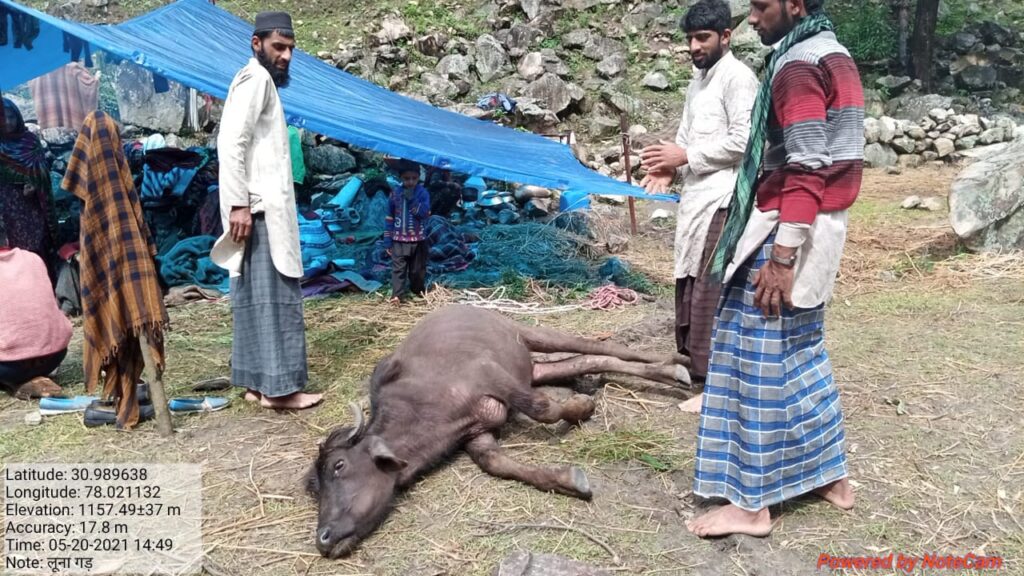
Settling down gravely impacts the carrying capacities of these ecosystems too. These lands deteriorate over time, and are eventually classified as ‘degraded forests’ by the Forest Department, owing to their inability to regenerate post continuous grazing.
The Van Gujjars recognise their impacts on the ecosystem when they do not migrate. Yet, unfortunately, the Forest Department uses this phenomenon as a pretext to highlight how the community’s overgrazing and encroachment is destroying forests, while simultaneously pushing for the eviction of the community from forest lands, and their resettlement too.
In 2021, How is Transhumance Coping with One Year of COVID-19 Policies?
In 2021, since migration commences usually in March, the Van Gujjars were not prohibited from migrating at the time. But by mid-April, while halfway along their routes, they were denied access to certain villages for interim stay or fodder for their livestock. Though initially there was no legal prohibition on their transit, which naturally adheres to physical distancing, this lockdown has reinvigorated fears of last year and its impact on livelihood.
At Uttarakhand’s Nagini, we bumped into Liaqat Kasana and Inam Chechi, who along with six families in their Qafila, were taking a break during the day in preparation of resuming their travel at night. The group started from Barkot range, near Bhaniyawala Dehradun district, and was due to reach their final destination in Ghansali, Tehri Garhwal district after 20 days. They narrated the changed scenario in 2021, while migrating in a world shaped by COVID-19.
“Most of the villagers were quite anxious and scared when we passed by their areas as the transit occurred while the 2nd wave was peaking across the state,” says Liaqat. “So, we were not allowed to graze or access water sources from village commons and had to decide on secluded spots to set up our padao.” Shabbir adds, “on average, we require four to five quintals of fodder which we previously cheaply procured from the villagers. But, due to COVID-19, we are forced to transport it all the way from Rishikesh, increasing our overhead costs of migration.”
Many Van Gujjars were afraid of being stuck at a padao in between destinations, and anxious about being ordered to traverse back to their winter homesteads. This fear was translated into reality for a group of 150 families in Netwad, Uttarkashi district, in May of 2021, when they were prohibited by the Deputy Director of Govind Pashu National Park, to enter the park’s core and buffer zone regions due to COVID-19 protocols. This is where the bugyals and their summer homesteads are located.
It is pertinent to note this is not the first time that the Forest Department has restricted the Van Gujjars from accessing the Govind Pashu National Park. The arbitrary actions of the Deputy Director of the National Park—citing the threat of COVID-19 for animals within the Protected Area, a reflection of fortress conservation—was used as a pretext to deny entry to the Van Gujjars. Despite not being the nodal authority for COVID-19 management, the harassment by the said officer forced the Van Gujjars, to set up temporary deras across Purola, Naitwad, Mori, Miyagadh, and Nasana Tapad areas, outside the National Park.
“Every summer, we are allowed to graze in Rupin, Supin, and Sankri areas of the Govind Pashu National Park, but the Forest Department is citing a circular restricting the entry of humans within National Parks to deny us access to our homes,” says Shamsher Ali, a Van Gujjar who migrates to Baikullu Thatch, Sankri range. “We are no tourists but are willing to pay grazing fees for the areas for which we possess valid permits.” This unexpected halt for over a month in open sheds led to the death of ten buffaloes as well as accentuated food insecurity amongst members of the community.
It was only after the Nainital High Court passed an order reprimanding the ‘animal existence’ that the community was being subjected to by the Forest Department, that the said families were allowed dignified entry into their summer homes.
Although the fascination for migration and nomadism is on the decline, some Van Gujjars are all too aware of the pitfalls of diminishing livelihoods and identities within existing resettlement colonies at Pathri and Gaindikhata in Haridwar district. Shabbir, whose summer residence is at Gidhara, Uttarkashi district, believes his large herd of 30 buffaloes requires transhumance and prefers nomadism over resettlement. In the absence of travel, Shabbir fears his buffaloes will die.
In this light, several members of the community rather than accepting predetermined resettlement policies by the Forest department are keen to ensure such initiatives must either resettle them where they are, or provide land at the forest fringes to ensure livelihoods are not severely impacted. The Forest Rights Act, 2006, accounts for their free prior informed consent for individual well as community land tenure, without restrictions to access forests, and the ability to pursue semi-nomadism for the health of their livestock and security of their livelihood. Any claim for resettlement and rehabilitation if based on the Act would have better negotiating power and results.
It is hopeful that the state adopts a diverse policy with respect to transhumance practiced by the Van Gujjars to realise their status of equal citizens. The constant harassment by the Forest Department ought to be withheld by the effective implementation of the Forest Rights Act, that recognises their permits as valid proofs in both their summer and winter homesteads. The Van Gujjars of Sankri range, subsequent to the verdict of the Nainital High Court, seem optimistic about filing their community claims to access the bugyals, and are swiftly forming their Forest Rights Committee and collecting paperwork. The communities also require the support of the local district administration to handhold the claim recognition process and map these territories, alongside that of the Forest Department to determine legitimate tenurial access for Van Gujjars in subsequent seasons.
Most importantly, it is also hoped that local villagers are sensitized to the sustainable grazing practices of the Van Gujjars to prevent the stigma and discrimination they face since the onset of the pandemic from heightening. Perhaps this would benefit the grey fortunes of another stationary pastoralist community: the Bakarwals of Jammu and Kashmir.
Featured image: a Van Gujjar’s at the bugyals of the Sankri range, in Govind Pashu Vihar National Park. | By Pranav Menon




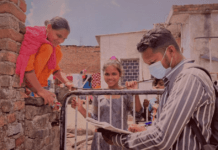


[…] May, the Deputy Director of Uttarakhand’s Govind Pashu National Park prohibited 150 Van Gujjar families from entering their summer bugyals (or alpine pastures) located inside the park’s core and buffer […]